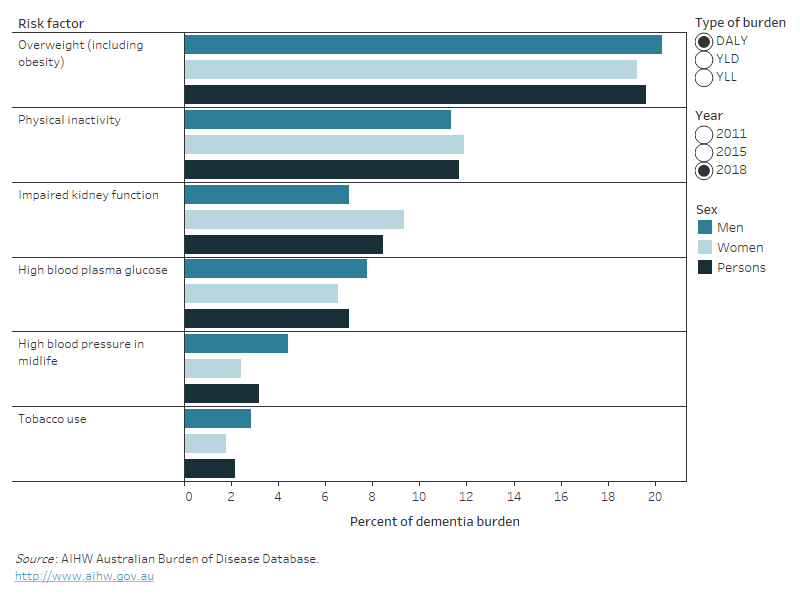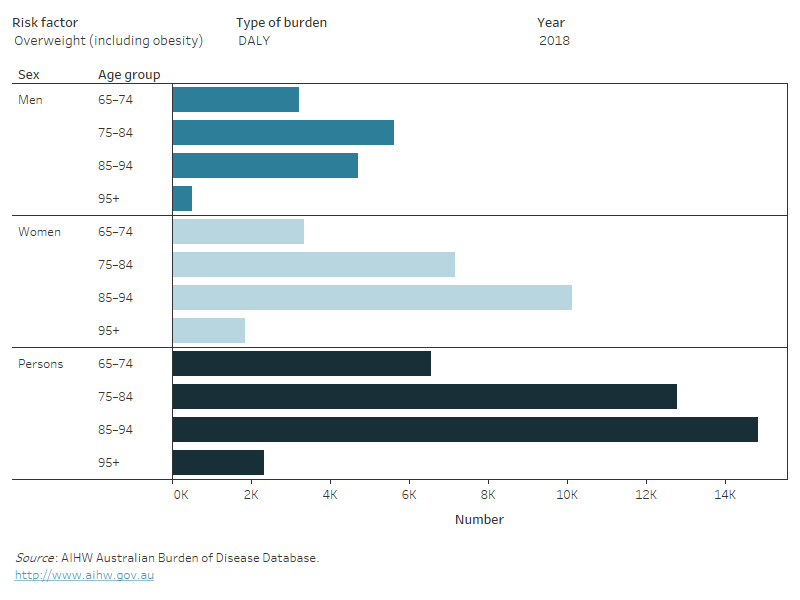Dementia burden due to risk factors
Disease burden due to risk factors is known as the attributable burden. It is measured as the number of healthy years of life lost that could have been avoided if exposure to the risk factor had been reduced or completely avoided.
The Australian Burden of Disease Study (ABDS) 2018 estimated the dementia burden attributable to 6 modifiable risk factors, including:
- tobacco use
- overweight and obesity
- physical inactivity
- high blood pressure in midlife (35–64 years)
- high blood plasma glucose
- impaired kidney function.
Note, this is not an exhaustive list of risk factors linked to dementia (for example, low education levels – an established risk factor for dementia – is not included) and only includes risk factors measured in the ABDS 2018. The list of risk factors and measures of additional risk (relative risks) were based on those used in recent Global Burden of Disease studies and a number of epidemiological studies. For more information on the complete list of established risk factors for dementia refer to What puts someone at risk of developing dementia?.
43% of the dementia burden was attributable to 6 risk factors
Overall, 43% of the dementia burden in 2018 was attributable to the 6 risk factors combined, equivalent to 84,800 DALY. This estimate takes into account the complex pathways and interactions between risk factors, such as the relationship between physical inactivity, overweight and obesity, and high blood pressure in midlife. However, this work does not incorporate the impact of age as a separate risk factor for dementia. Age is the main risk factor for dementia but because it is not a modifiable risk factor, it is not included in this report.
When looking at each risk factors’ contribution to the total burden due to dementia (Figure 4.5):
- 20% was attributable to overweight and obesity (38,900 DALY)
- 12% was attributable to physical inactivity (23,100 DALY)
- 8.4% was attributable to impaired kidney function (16,700 DALY)
- 7.0% was attributable to high blood plasma glucose (13,900 DALY)
- 3.2% was attributable to high blood pressure in midlife (6,300 DALY)
- 2.2% was attributable to tobacco use (4,300 DALY).
While there was little difference in the proportion of dementia burden attributable to the 6 risk factors between men and women, the number of attributable DALY was often lower in men compared with women. This is due to women overall experiencing a greater amount of burden due to dementia than men.
Between 2011 and 2018, the proportion of dementia burden attributable to the 6 risk factors combined increased by 2%. However, this varied when looking at each risk factor. The proportion of dementia burden attributable to high blood pressure in midlife and tobacco use decreased (by 22% and 10%, respectively) whereas this increased for overweight and obesity (by 9.0%) and high blood plasma glucose (3.5%). For impaired kidney function and physical inactivity, this was stable over time.
Figure 4.5: Dementia burden in Australia attributable to specific risk factors in 2011, 2015 and 2018, by sex: percentage of DALY, YLL and YLD
Figure 4.5 is a bar graph showing the percentage of years of life lost, years lived with disability and disability-adjusted life years (DALY) due to dementia that were attributable to specific risk factors in Australia by sex in 2011, 2015 and 2018. Risk factors include tobacco use, overweight and obesity, physical inactivity, high blood pressure in midlife (35–64 years), high blood plasma glucose and impaired kidney function. Overall, overweight and obesity was the greatest contributor to disability-adjusted life years due to dementia, followed by physical inactivity. There was little difference in the proportion of dementia DALY attributable to the 6 risk factors by sex. Between 2011 and 2018, the proportion of dementia DALY attributable to overweight and obesity and high blood plasma glucose increased, whereas this decreased for high blood pressure in mid-life and tobacco use.

How do risk factors impact dementia burden by age?
The amount of dementia burden attributable to each risk factor varied by age. This is due to age differences in both exposure to the risk factor, as well as the burden of dementia by age. The attributable dementia burden was estimated in all ages, except for high blood pressure in midlife, which was estimated for burden due to dementia in people aged 65 and over.
The dementia burden attributable to each risk factor (besides tobacco use) was greatest in people aged 85–94 (Figure 4.6). Dementia burden attributable to tobacco use was greatest in a slightly younger age group (people aged 75–84).
For most risk factors, the total dementia burden attributable to each risk factor was higher in women than men aged 85 and over. However, among those aged 65–74, the dementia burden attributable to each risk factor was generally higher in men than women.
Between 2011 and 2018, there was little difference between age groups in changes to the proportion of the dementia burden attributable to high blood pressure in midlife, overweight and obesity and physical inactivity. However, the proportion attributable to high blood plasma glucose and impaired kidney function either increased or decreased depending on the age group. This suggests there were age-specific changes in the exposure to these 2 risk factors between 2011 and 2018.
Figure 4.6: Dementia burden attributable to specific risk factors in 2011, 2015 and 2018, by age and sex: YLL, YLD and DALY
Figure 4.6 is a bar graph showing the number of years of life lost, years lived with disability and disability-adjusted life years (DALY) due to dementia that were attributable to specific risk factors in Australia by sex and age in 2011, 2015 and 2018. Risk factors include tobacco use, overweight and obesity, physical inactivity, high blood pressure in midlife (35–64 years), high blood plasma glucose and impaired kidney function. Besides tobacco use, the dementia DALY attributable to each risk factor was greatest among those aged 85–94. The dementia DALY attributable to each risk factor was generally higher for females in the older age groups but higher in males in the youngest age groups.

How do risk factors impact dementia burden by socioeconomic area?
The amount of dementia burden attributable to each risk factor varied by socioeconomic area. Poorer health outcomes are generally observed as greater rates of burden in lower socioeconomic areas. This disparity is influenced by a complex and interrelated set of social and economic factors, including reduced access to health services, lower resource availability, lower levels of education and the influence of uptake of risky behaviours (AIHW 2021).
Taking into account the different age structures in each socioeconomic area, dementia burden attributable to the 6 risk factors combined decreased with increasing socioeconomic area, and was 1.4 times as high in the lowest socioeconomic area (3.1 DALY per 1,000 population) as in the highest area (2.2 DALY per 1,000 population) (Figure 4.7).
The rates of dementia burden attributable to each individual risk factor were consistently higher in the lowest socioeconomic areas than in the highest socioeconomic areas. The greatest difference was seen for tobacco use (2.4 times higher in the lowest socioeconomic area) and high blood plasma glucose (2.2 times higher). In each socioeconomic area, men had higher rates of dementia burden attributable to high blood pressure in midlife and (except for the lowest socioeconomic area) tobacco use than women, and women had higher rates of dementia burden attributable to physical inactivity and impaired kidney function than men.
Figure 4.7: Dementia burden attributable to specific risk factors, by socioeconomic group: age-standardised YLL, YLD and DALY per 1,000 people
Figure 4.7 is a bar graph showing the age-standardised rates of years of life lost (YLL), years lived with disability (YLD) and disability-adjusted life years (DALY) due to dementia that were attributable to specific risk factors in Australia in 2018 for men, women and persons by socioeconomic areas. Risk factors include tobacco use, overweight and obesity, physical inactivity, high blood pressure in midlife (35–64 years), high blood plasma glucose and impaired kidney function. The rates of dementia DALY attributable to each risk factor were consistently higher in the lowest socioeconomic areas than in the highest socioeconomic areas, with the greatest difference seen for tobacco use and high blood plasma glucose. Males had higher rates of dementia DALY attributable to high blood pressure in midlife, high blood plasma glucose levels and tobacco use than females for most socioeconomic areas. Females had higher rates of dementia DALY attributable to physical inactivity and impaired kidney function.

AIHW (Australian Institute of Health and Welfare) (2021) Australian Burden of Disease Study: impact and causes of illness and death in Australia 2018, AIHW, Australian Government, accessed 12 December 2022.


